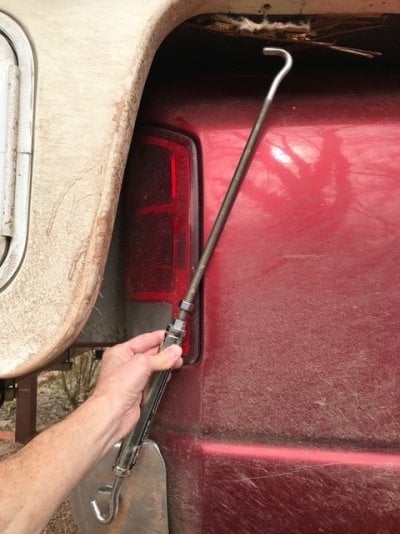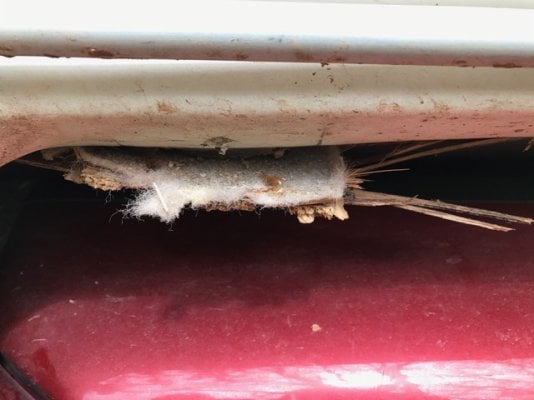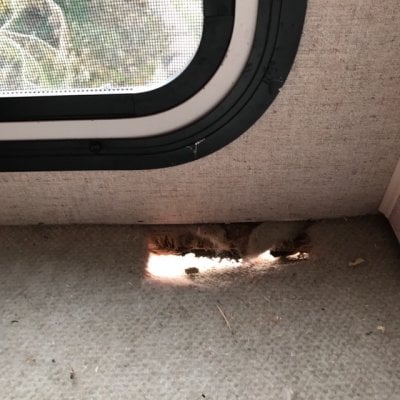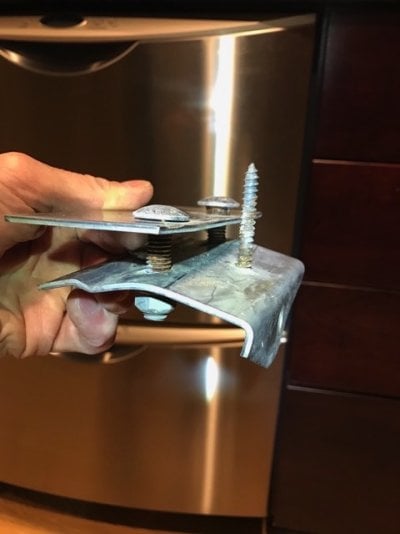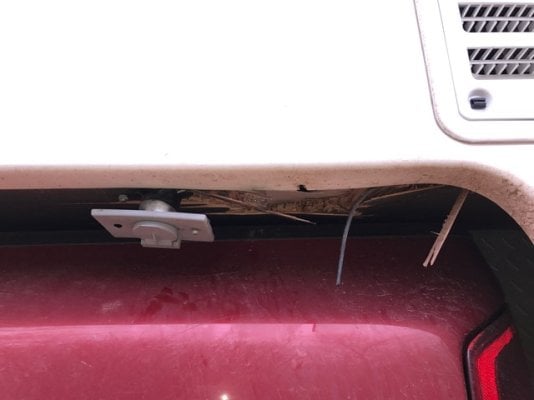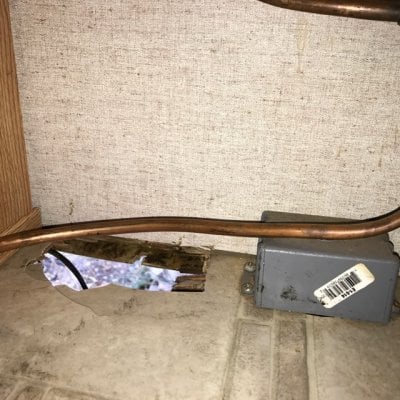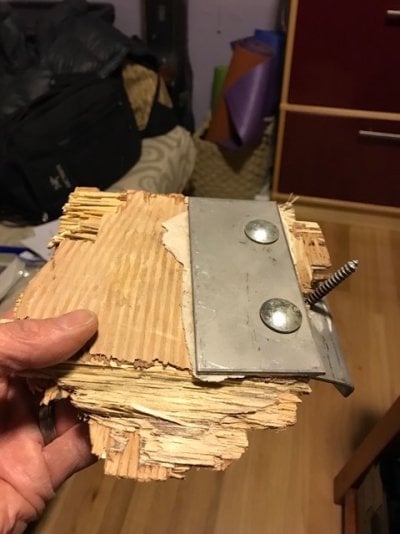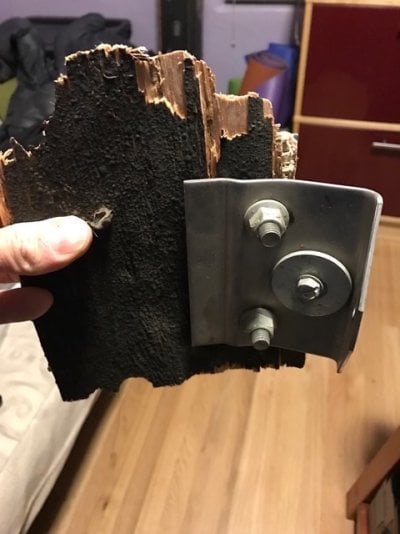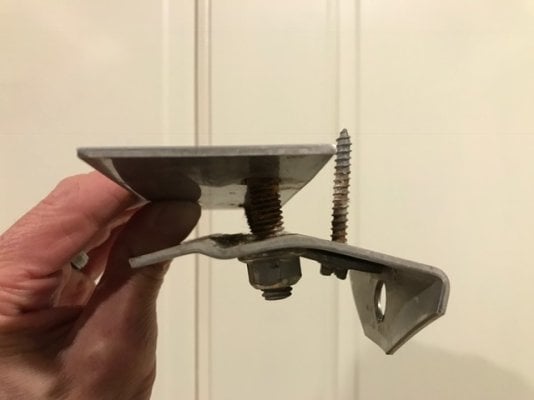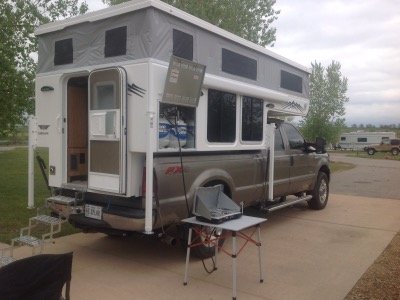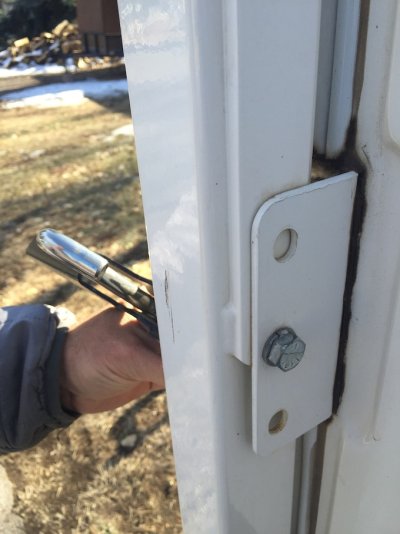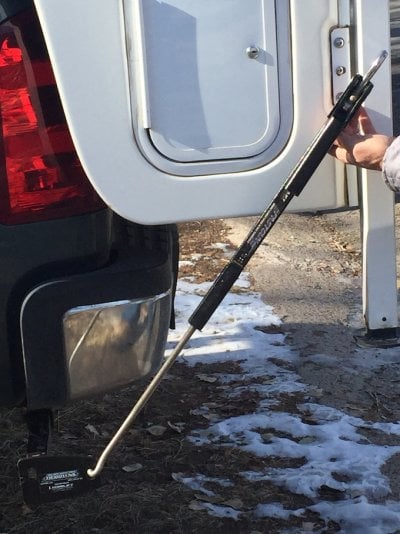DoGMAtix
Senior Member
We have an 08 Hallmark Guanella mounted on an 06 Dodge Ram 2500 CTD short bed (6 1/3 foot bed). We’ve been working on the camper mounting system with the intent of taking it regularly on rugged 4WD roads in Utah’s canyon country and the southern Colorado Rockies. We’ve got Hallmark-installed Happijac tie downs (http://happijac.com/tie-downs.html) and Torklift Anchor Guard turnbuckles, as described in a previous post (http://www.wanderthewest.com/forum/topic/11134-mounting-hallmark-guanella-on-dodge-ram-2500-short-bed-project/ ).
We went on our first trip involving extensive driving on rough/rocky dirt roads in the Maze District of Canyonlands last week, and seemed to be doing really well after a couple of long driving days. However, on a relatively smooth stretch we failed to notice a shallow erosion channel across the road and hit it at maybe 10-15 MPH. There was a WUMP and a jolt, not that much bigger than some we’d experienced previously, well within what I’d expect the rig to stand up to, but big enough to make us check the rear views to make sure everything was OK… and it wasn’t.
The rear turnbuckle mounts on the camper had failed catastrophically. The metal mounting plates on the overhangs on both sides had torn clean out (along with a chunk of plywood each) and were lying in the dirt. Photos show where the plates tore through, with closeups of the gaping holes where they’d been (under the carpeting in the back of the dinette seating area and under the linoleum in the cabinet under the cooktop). One pair of photos shows a set of plates with the torn-out plywood chunk still wedged in-between, from top and bottom views. The plywood does not appear to have rotted, but after 8 yrs on the underside of a camper (coated with black “weatherproofing” stuff that may or may not be a good idea per posts I’ve read) I suppose it had lost some degree of integrity.
Anyhow, the main point of this thread is that we’re left with 2 gaping holes to fix and at the same time create new rear turnbuckle mounting points on the camper in roughly the same location that will hold up to further (ab)use. In order to avoid ripping the new mounting points out like we did the old ones, we need to satisfy either or both of the following conditions:
1) Create stronger mounting points,
2) Decrease the forces generated by turnbuckle pull.
For stronger mounting points, the plan is to create plates much larger than the originals to sit on top of the plywood around the holes and disperse the forces over a greater area (the old plates were just 2 1/4" by 5", the new ones will probably be about 12" x 12"). The plates that clamp onto the underside will also have to be larger to hold the sandwich together tightly, but will be limited by the width of the overhang (about 10 inches). Although the plywood bordering the holes is probably compromised, if we make the upper plates quite large we should be OK. 1/8” aluminum should suffice on top, 1/16” probably adequate on bottom. It would be ideal to replace the plywood boards that were damaged in the process as well, but that would require a massive camper rebuild, which Bill (Ward, of Hallmark) said would be expensive, time consuming, and most likely unnecessary. In order to get the most strength out of a compromised overhang structure, we plan to make 90 degree bends in the plates to fasten them to the vertical structures coming up just behind the holes (the fridge cabinet on the driver’s side and the closet on the passenger’s side). Should be able to fit carriage bolts in there without much problem – I figure the flat heads on the passenger side can go behind the dinette cushion, and on the driver’s side they can go inside the fridge cabinet (we’ll probably have to take the fridge out to do that). There will be space for the nuts and bolt ends in the closet and in the under-stove cabinet. We may try to put a 90 degree bend upward along the camper sidewall as well, but not sure we’d want to drill into or through that wall... we'll see.
We’ve got a metal fabricator in town who works on off-road vehicles, has a great reputation and seems like a stand up guy who knows his stuff. We’d been planning to have him make skid plates for the gas tank and transfer case on our truck, so now we’ll just have a little bit bigger job for him.
Regarding limiting maximal forces generated by the turnbuckles against the mounting points, I’ve been talking to the folks at Torklift. It seems intuitive to me that the rear turnbuckles should be spring-loaded to deliver force in as gradual a tug as possible, and the fronts shouldn’t need to give much since the goal is to keep the camper snugged up to the front of the bed at all times (in fact, we found that our front turnbuckles worked their way loose occasionally on bumpy downhills, which may well have been due to greater turnbuckle expansion/contraction with springs). However, both Torklift and Happijac recommend sprung turnbuckles up front and damped turnbuckles in the rear. Bill at Hallmark has an aerospace engineering background and he feels the same way I do; in fact, he routinely swaps the barrels of the front and rear turnbuckles out. Torklift’s response to this is that the majority of the camper’s weight and therefore forces generated are up front, so springs are needed there.
For now I’m just going to focus on putting in plates with as much structural strength as possible so whatever we do with the turnbuckles will be less likely to result in mounting point damage.
If anyone has advice based on experience or expertise, I’d appreciate it.
I’ll update with photos as the project progresses.
- Dave
We went on our first trip involving extensive driving on rough/rocky dirt roads in the Maze District of Canyonlands last week, and seemed to be doing really well after a couple of long driving days. However, on a relatively smooth stretch we failed to notice a shallow erosion channel across the road and hit it at maybe 10-15 MPH. There was a WUMP and a jolt, not that much bigger than some we’d experienced previously, well within what I’d expect the rig to stand up to, but big enough to make us check the rear views to make sure everything was OK… and it wasn’t.
The rear turnbuckle mounts on the camper had failed catastrophically. The metal mounting plates on the overhangs on both sides had torn clean out (along with a chunk of plywood each) and were lying in the dirt. Photos show where the plates tore through, with closeups of the gaping holes where they’d been (under the carpeting in the back of the dinette seating area and under the linoleum in the cabinet under the cooktop). One pair of photos shows a set of plates with the torn-out plywood chunk still wedged in-between, from top and bottom views. The plywood does not appear to have rotted, but after 8 yrs on the underside of a camper (coated with black “weatherproofing” stuff that may or may not be a good idea per posts I’ve read) I suppose it had lost some degree of integrity.
Anyhow, the main point of this thread is that we’re left with 2 gaping holes to fix and at the same time create new rear turnbuckle mounting points on the camper in roughly the same location that will hold up to further (ab)use. In order to avoid ripping the new mounting points out like we did the old ones, we need to satisfy either or both of the following conditions:
1) Create stronger mounting points,
2) Decrease the forces generated by turnbuckle pull.
For stronger mounting points, the plan is to create plates much larger than the originals to sit on top of the plywood around the holes and disperse the forces over a greater area (the old plates were just 2 1/4" by 5", the new ones will probably be about 12" x 12"). The plates that clamp onto the underside will also have to be larger to hold the sandwich together tightly, but will be limited by the width of the overhang (about 10 inches). Although the plywood bordering the holes is probably compromised, if we make the upper plates quite large we should be OK. 1/8” aluminum should suffice on top, 1/16” probably adequate on bottom. It would be ideal to replace the plywood boards that were damaged in the process as well, but that would require a massive camper rebuild, which Bill (Ward, of Hallmark) said would be expensive, time consuming, and most likely unnecessary. In order to get the most strength out of a compromised overhang structure, we plan to make 90 degree bends in the plates to fasten them to the vertical structures coming up just behind the holes (the fridge cabinet on the driver’s side and the closet on the passenger’s side). Should be able to fit carriage bolts in there without much problem – I figure the flat heads on the passenger side can go behind the dinette cushion, and on the driver’s side they can go inside the fridge cabinet (we’ll probably have to take the fridge out to do that). There will be space for the nuts and bolt ends in the closet and in the under-stove cabinet. We may try to put a 90 degree bend upward along the camper sidewall as well, but not sure we’d want to drill into or through that wall... we'll see.
We’ve got a metal fabricator in town who works on off-road vehicles, has a great reputation and seems like a stand up guy who knows his stuff. We’d been planning to have him make skid plates for the gas tank and transfer case on our truck, so now we’ll just have a little bit bigger job for him.
Regarding limiting maximal forces generated by the turnbuckles against the mounting points, I’ve been talking to the folks at Torklift. It seems intuitive to me that the rear turnbuckles should be spring-loaded to deliver force in as gradual a tug as possible, and the fronts shouldn’t need to give much since the goal is to keep the camper snugged up to the front of the bed at all times (in fact, we found that our front turnbuckles worked their way loose occasionally on bumpy downhills, which may well have been due to greater turnbuckle expansion/contraction with springs). However, both Torklift and Happijac recommend sprung turnbuckles up front and damped turnbuckles in the rear. Bill at Hallmark has an aerospace engineering background and he feels the same way I do; in fact, he routinely swaps the barrels of the front and rear turnbuckles out. Torklift’s response to this is that the majority of the camper’s weight and therefore forces generated are up front, so springs are needed there.
For now I’m just going to focus on putting in plates with as much structural strength as possible so whatever we do with the turnbuckles will be less likely to result in mounting point damage.
If anyone has advice based on experience or expertise, I’d appreciate it.
I’ll update with photos as the project progresses.
- Dave

